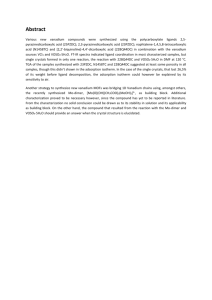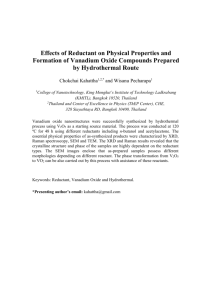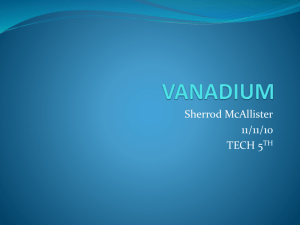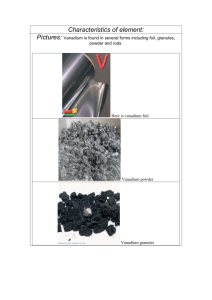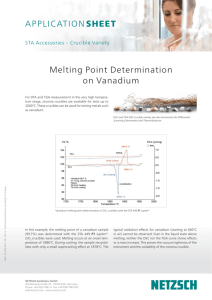FACT SHEET
advertisement
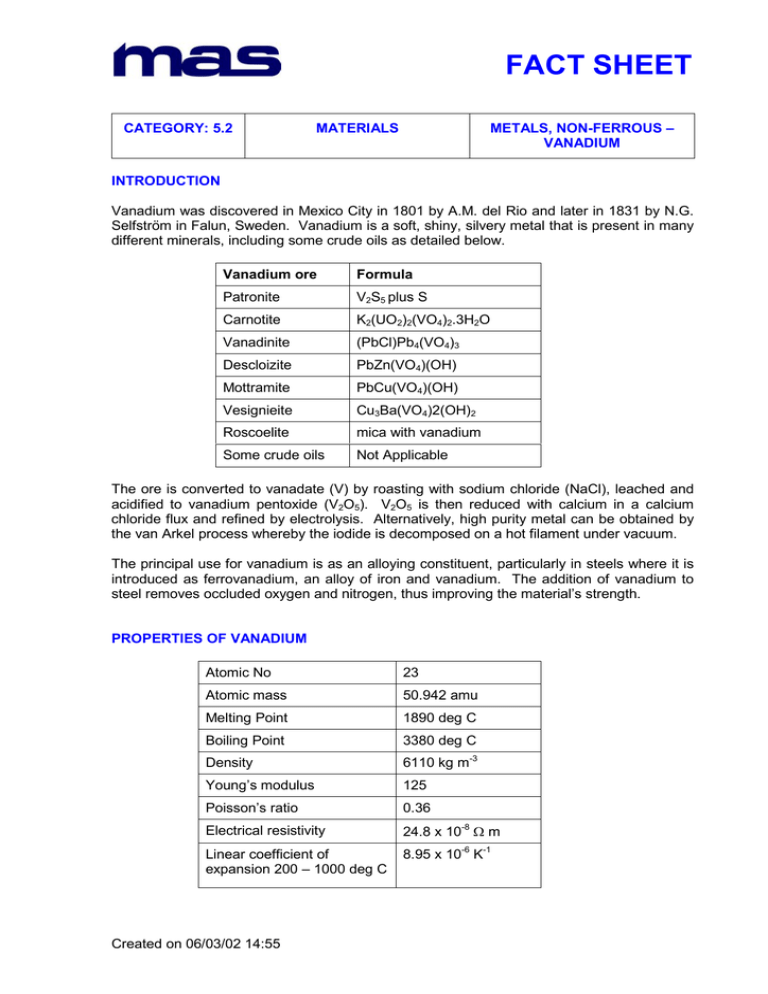
FACT SHEET CATEGORY: 5.2 MATERIALS METALS, NON-FERROUS – VANADIUM INTRODUCTION Vanadium was discovered in Mexico City in 1801 by A.M. del Rio and later in 1831 by N.G. Selfström in Falun, Sweden. Vanadium is a soft, shiny, silvery metal that is present in many different minerals, including some crude oils as detailed below. Vanadium ore Formula Patronite V2S5 plus S Carnotite K2(UO2)2(VO4)2.3H2O Vanadinite (PbCl)Pb4(VO4)3 Descloizite PbZn(VO4)(OH) Mottramite PbCu(VO4)(OH) Vesignieite Cu3Ba(VO4)2(OH)2 Roscoelite mica with vanadium Some crude oils Not Applicable The ore is converted to vanadate (V) by roasting with sodium chloride (NaCl), leached and acidified to vanadium pentoxide (V2O5). V2O5 is then reduced with calcium in a calcium chloride flux and refined by electrolysis. Alternatively, high purity metal can be obtained by the van Arkel process whereby the iodide is decomposed on a hot filament under vacuum. The principal use for vanadium is as an alloying constituent, particularly in steels where it is introduced as ferrovanadium, an alloy of iron and vanadium. The addition of vanadium to steel removes occluded oxygen and nitrogen, thus improving the material’s strength. PROPERTIES OF VANADIUM Atomic No 23 Atomic mass 50.942 amu Melting Point 1890 deg C Boiling Point 3380 deg C Density 6110 kg m-3 Young’s modulus 125 Poisson’s ratio 0.36 Electrical resistivity 24.8 x 10-8 W m Linear coefficient of expansion 200 – 1000 deg C 8.95 x 10-6 K-1 Created on 06/03/02 14:55 FACT SHEET In its high purity form, it is very soft and ductile. But it can be hardened and embrittled by oxygen, nitrogen, carbon and hydrogen. It is referred to as a refractory metal because of its high melting point. Pure vanadium resists corrosion due to the formation of a protective oxide film on its surface; it resists attack from alkalis but is susceptible to attack by concentrated acids. USES OF VANADIUM Vanadium is easily converted into chemicals which have many industrial and domestic uses and which are also used in the preparation of other products. Vanadium is used mostly in production of rust resistant and high-speed tool steels. About 80% of the Vanadium now produced is used as ferrovanadium or as a steel additive. Vanadium steel is especially strong and hard, and has improved resistance to shock. When added to steel in amounts between 0.1 - 5.0%, it refines the grain of the steel matrix and forms carbides with the carbon present in the steel. Vanadium foil is used as a bonding agent in cladding titanium to steel and generally by the aerospace industry in titanium alloys, enabling them to be used in high temperature environments (e.g. gas turbine compressor blades). Medical implants often contain vanadium alloys that contribute to their longevity. Vanadium has catalytic properties that make it useful in many industrial applications. Vanadium Pentoxide is used as a catalyst in the production of sulphuric acid where sulphur dioxide is passed over a V2O5 catalyst bed and oxidized to sulphur trixoxide. It is also employed as a catalyst in the manufacture of maleic anhydride: a chemical needed to make polyester resins and fiberglass. (VANADIUM) INTERNET RESOURCES VANITEC promotes the use of vanadium in both scientific and industrial arenas. http://www.vanitec.org/ World market overview on http://www.roskill.co.uk/vanadium.html vanadium is presented by Roskill. General information regarding vanadium is available form the Chemical Society in .pdf format. http://www.chemsoc.org/viselements/pages/pdf/vanadium.PDF Created on 06/03/02 14:55
